
 |
|
|
|
|
#1 |
|
Member
Join Date: Dec 2004
Location: Sint-Amandsberg (near Ghent, Belgium)
Posts: 830
|
I found this dagger on a small Belgian auction site (yes, we have these,too
 ). The seller's description mentioned a handle made from bone. So I ended up buying this curious thing. ). The seller's description mentioned a handle made from bone. So I ended up buying this curious thing.This morning, I received it and was very pleased with what I got. Only....I'm not sure what I've got. After examining the piece, I noticed that the round metal guard between the blade and the handle is a coin. On it I can read : Indochine - 1939. So I presume it has a Southeast Asian origin. Would it be that old ?  The blade is crudely forged, with the cutting edge on the curved side. It has a strong back, 3 mm thick. The handle is made from some kind of animal bone with a good patina. Near the guard the handle is reinforced with a metal ring. The wooden sheath consists of two pieces, held together with some rattan binding and a metal band near the top. Measurments : total length : 34 cm length of blade : 20,5 cm length of handle : 11 cm 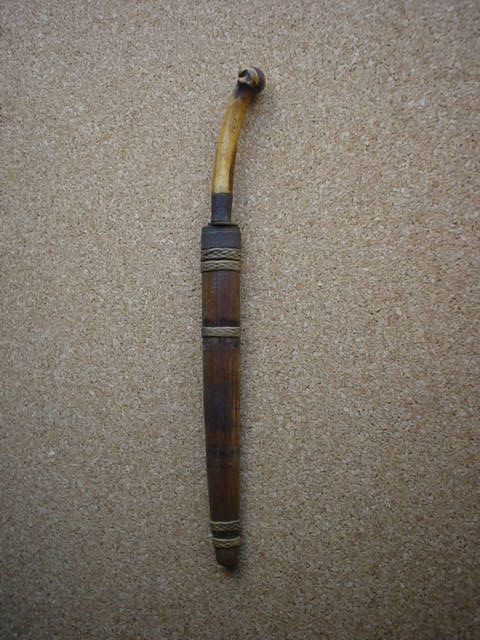 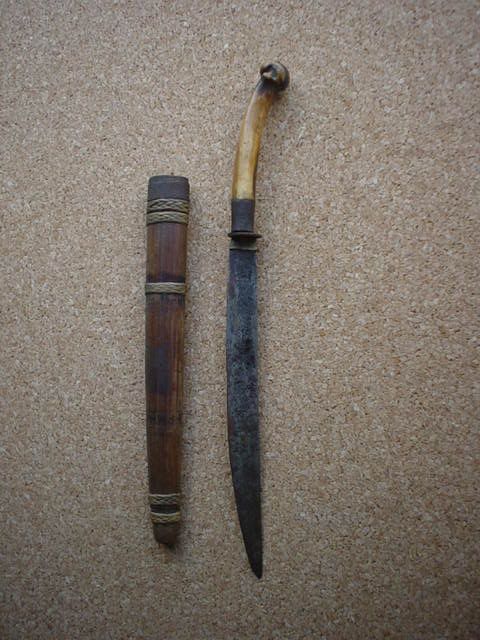  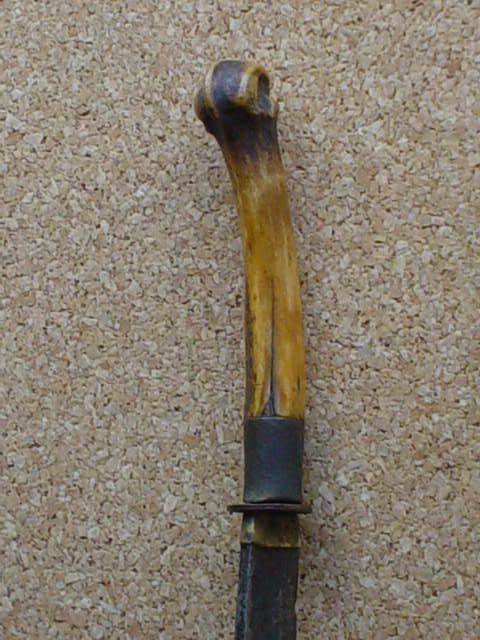 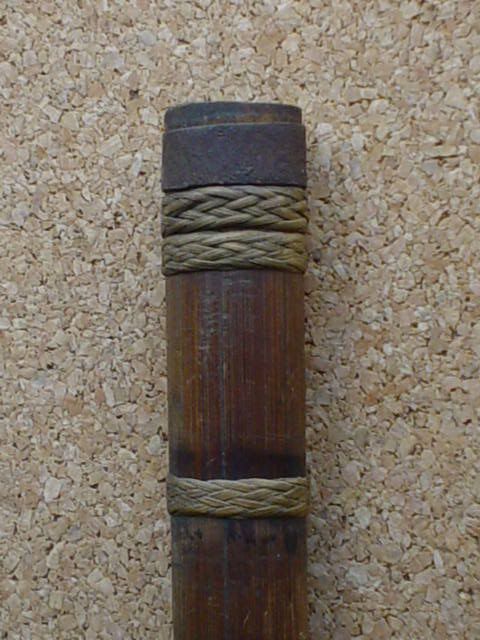 I would appreciate your opions. 
|
|
|

|
|
|
#2 |
|
Member
Join Date: Dec 2004
Location: Italia
Posts: 1,243
|
Hey Freddy, tell us the link to this small Belgian auction site
 Great knife!! |
|
|

|
|
|
#3 |
|
Member
Join Date: Dec 2004
Location: Sint-Amandsberg (near Ghent, Belgium)
Posts: 830
|
Here's a nice one :
http://www.delcampe.com/main.php?aff...gle&language=D And here's a 'crash course' in Dutch  : :dagger = dolk knife = mes sword = zwaard spear = speer Freddy |
|
|

|
|
|
#4 |
|
Member
Join Date: Dec 2004
Location: Italia
Posts: 1,243
|
Thank you Freddy nice site

|
|
|

|
|
|
#5 |
|
Member
Join Date: Dec 2004
Location: What is still UK
Posts: 5,806
|
You have done it again, what a stunning piece, I love the handle. It would be intresting to find what the bone came from. My first thoughts are it is maybe from Burma then possibly anywhere between there and Indonesia. Somewhere that has monkeys? Tim
|
|
|

|
|
|
#6 | |
|
Member
Join Date: Dec 2004
Posts: 987
|
Quote:
Ian has a bunch of swords from that area, so I expect he will have more to say. |
|
|
|

|
|
|
#7 |
|
Member
Join Date: Dec 2004
Posts: 1,247
|
Hi Freddy,
Neat knife! My vote's with Mark, but my first thought on seeing it was, "Oh, that's a quick-change dha." What's a quick-change dha, do you ask? A quick-change dha is where you say, with total confidence, "Oh, that's a dha," and quickly change the subject.    My take is it's hard to put a terminal ferrule on a leg bone, and that someone in "Dha country" (perhaps a Hmong?) thought that the bone would be cool as a knife handle. Fearn |
|
|

|
|
|
#8 |
|
Vikingsword Staff
Join Date: Dec 2004
Location: The Aussie Bush
Posts: 4,197
|
Hi Freddy:
Not a dha IMO for several reasons, but close geographically. First, the collar next to the small circular guard is reminiscent of an habaki (as Mark noted), and this Japanese style is found rarely on S. Vietnamese swords/knives but is absent on traditional dha. I have an old sword-length example of a Viet dha/dao with pictures on the old site I will try to find. A small circular guard is seen on some dha from Thailand, Laos, Cambodia. Second, the rattan work on the scabbard bindings is very coarse and atypical for usual dha scabbards (Burmese, Thai, Lao and Cambodian scabbards feature finely plaited rattan) -- more reminiscent of the Philippines, Borneo, and possibly Vietnam. Third, there is a slight swell to the blade width. There are definitely dha with this feature (notably northern Thai, Lao, and perhaps Cambodian; almost never Burmese), while some Vietnamese knives also have this profile. You can see where this is heading. My best guess is Vietnamese, more likely southern rather than northern. Interesting knife. What'ya want for it Freddy?  Ian. Edit: I just reread Freddy's original post and had missed mention of the Indochine coin the first time. That certainly makes a Vietnamese origin very likely. What is today Vietnam, Cambodia and Laos comprised French IndoChina in the latter part of the 19th and first half of the 20th C. It makes sense that a knife from French IndoChina would end up in France and be found in a small Belgium auction. Great find Freddy -- swords and knives from this area and era are uncommon. Congratulations. Ian. Here is the old picture of the Vietnamese sword I mentioned above: 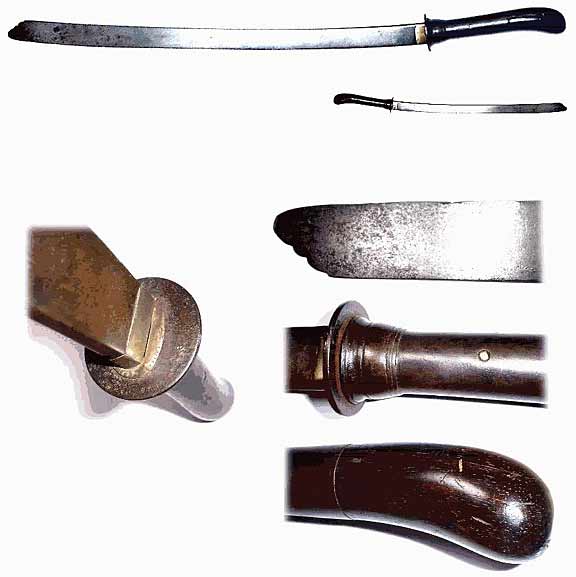 Last edited by Ian; 17th August 2005 at 09:12 AM. Reason: Adding picture |
|
|

|
|
|
#9 |
|
Member
Join Date: Dec 2004
Location: What is still UK
Posts: 5,806
|
We often here the term "crude" but this bothers me. I associate crude with something badly made. Something may appear very simply made but that is not crude. A fine finnish is not always the desired goal, just a basic function and comfortable feel in the hand. Some of the things termed crude may have been made in the most humble of forges with very little in the way of tools. The materials and customers may have been quite scarce, poor, happy with and more importantly only knowing a local aesthetic. These are among the main points of interest in my collecting. I guess it is a bit like carpets with collectors of town or nomadic pieces. Tim
Last edited by Tim Simmons; 17th August 2005 at 10:10 PM. Reason: SPELLING!!! |
|
|

|
 |
|
|